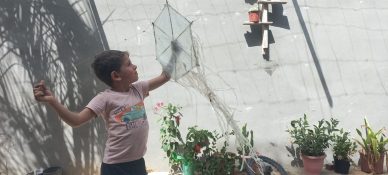Coloring eggs using beautiful colors during the month of April and distributing them among the poor and the children is a very old habit in the occupied West Bank a tradition that brings people back to old history although most of those who color eggs don’t know the origin of this tradition.
Onions’ Peel
Khadija Hassan from Nablus says: “My grandmother told me the month of April is made of four Thursdays: plants Thursday sweets Thursday girls Thursday and the dead Thursday.”
“The Thursday of eggs is the second in the month and some call it the Thursday of the dead where people visit graves and distribute eggs. We used to rejoice it at the Rafidia neighborhood of Nablus where we would make eggs color and boil them with peel of onions and the colors of the Thursday of eggs.”
Other colors
Hala Mustafa from Ramallah recalls the Thursday of eggs “My grandmother used to buy a carton of eggs coloring eggs with peel of onions and distributing them among us as we enjoyed playing with the colored eggs all day long.”
“After boiling the peel of onions with eggs they become red making eggs red too while almond leaves become green and walnut leaves become black.”
She adds “We were young and we would rejoice this habit which we didn’t know its origins. Now I recall these days and distribute eggs to the neighbors and their children are happy for having things for free and colors to play with while some of them eat the eggs if they are hungry.”
Coloring eggs is a very ancient tradition of 5000 years old followed by the ancient Egyptians to celebrate the oldest festivals of mankind at all: the feasts of Sham Ennessim or the coming of Spring. Celebrations of this feast include boat rides in the Nile singing and decorating houses with flowers and coloring eggs.
Thursday Origin
According to the ancient history teacher Ayoub Mahmoud from Ramallah the origin of the tradition is linked to the art of decoration and coloring eggs in some cultures including the people of Central Europe during Easter.
This tradition dates back to the pagan times when people celebrated spring and the return of fertility. At that time people used colored eggs in their celebrations which has a symbolic significance to fertility as it is known. Remains of eggs were found in prehistoric graves prior to the spread of Christianity which gave the practice a new religious dimension.
He continued: “Since 325 AD the church celebrates Easter as part of a religious ritual and people used to distribute sweets in this celebration until the 19th century where they began exchanging colored eggs with golden paper reviving an old tradition that came to life centuries before Easter. Ancient Egyptians adopted eggs as a symbol of life fertility and the continuity of life. They used to exchange eggs as a gift to the extent they would bury them in the graves of their dead so did the Greeks and the Romans who used to believe in the myth that says: life comes from an egg.
He concluded by saying: “Because life comes from an egg the Pharaohs chose eggs to be a well-established tradition in the feast of Sham Ennessim – the Spring Festival and the renewal of life – as there were many methods of coloring and painting on the eggs’ thin crust with very precise drawings.”















